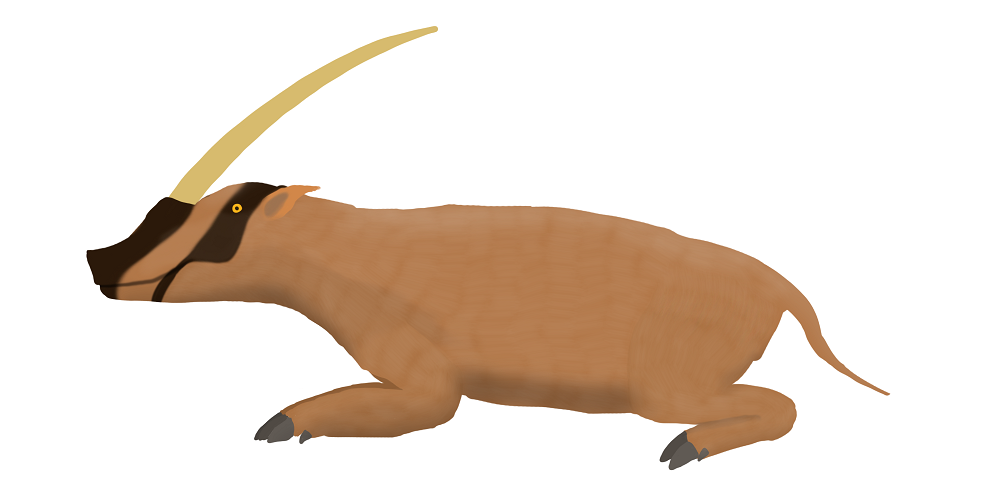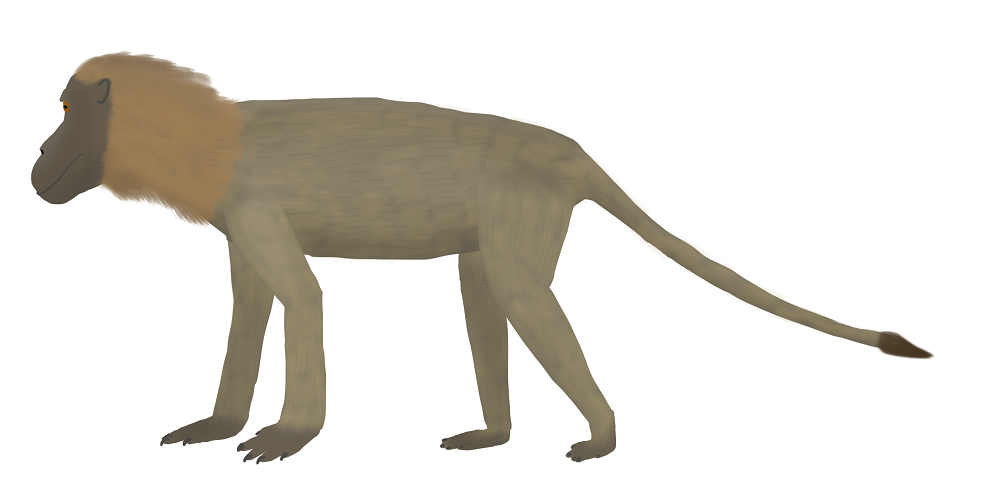
|
Ethiopian Savanna
40 million years hence
40 million years in the future, the continent of Africa has broken in two along the Ethiopian rift valley. As the Somali Plate moved to the east, the new continent of Somalia was severed by sea from mainland Africa 30 million years prior. The two African continents, while similar in climate, have evolved completely different faunas. As Africa collides with Europe, allowing for faunal intermixture, East Africa remains isolated, and undergoing a unique path of evolution.
A significant component of East African faunas are the antrats: tiny, eusocial burrowing rodents that construct mounds and complex societies. New species have arisen to specifically feed upon these, such as rodent-specialist hyenas and birds. Other members of the East African savanna ecosystem include predatory baboons, antelopes, and numerous pig species.
| Eastern manticore |
Greater ant-hyena |
Scimitar hog |
Stalking-hornbill |
|
Click on a tab to learn more about that species.

Coronochoerus leei
Pigs have done well in the later Cenozoic, diversifying on almost all continents. One of these, the scimitar hog, hails from drier areas of East Africa. Although it is omnivorous, the vast majority of its diet consists of grasses and roots, often digging plants out of the ground entirely before eating. Curiously, it appears to favor digging with its forelimbs over using its snout.
Both sexes have a large pair of tusks projecting out of the top of the skull. These tusks, which can grow up to one meter in length, are parallel and bear no enamel coating. They are thicker and straighter than in the babirusa, and thus pose little self-impalation hazard. Males use these tusks in territorial spars, while females use the tusks to defend their offspring.

Ursyaena aethiopica
A new clade has evolved to fill the niche formerly held by pangolins: the ant-hyenas. These insectivorous hyenas range across Africa and southern Asia. This clade has evolved many adaptations for insect-eating, such as elongate tongues and long, inward-facing claws on their forelimbs (which necessitate knuckle-walking in many species). Most are around the size of a large fox, and several species are arboreal.
On the island continent of East Africa, however, ant-hyenas are much more diverse. Many have evolved to specialize in eating the colonial mole-rats plentiful on this continent. Ursyaena is one of these mole-rat specialists. The largest species, U. aethiopica, can grow to three meters long and over 70 centimeters at the hip. It is also bipedal to a greater degree than other ant-hyenas; although many are capable of standing bipedally, Ursyaena spends most of its time on its hind legs. The tongue of Ursyaena is long, sticky, and bears hooklike papillae to assist with grabbing prey.

Venatopithecus chaetophorus
The eastern manticore is one of the predators of the continent of East Africa. Manticores are macropredatory baboons, filling the niches once held by big cats on both African continents. Manticores are generally more solitary creatures than their ancestors, hunting either alone or in loose troops. Both sexes have manes, but it is much larger in males. Unlike their mythological namesake, manticores do not bear venomous spines, but instead implement pointed teeth, clawlike nails, and the occasional stick in the dispatching of prey.

Venatoceros aethiopicus
Stalking-hornbills can be found in relatively open habitats throughout Africa and central Asia 40 million years in the future. These birds have traded flight for size; the largest species, such as the East African Venatoceros aethiopicus, can grow to three meters in height. This species has extensive featherless areas on its underside; this helps with heat dissipation in hot savanna environments.
Stalking-hornbills are so named due to their style of hunting: they roam grasslands in search of small reptiles and mammals. Their long necks provide leverage from which they may grab their prey and swallow it whole. This is an extension of the foraging habits of modern ground hornbills. Stalking-hornbills can be found in many of the same areas as manticores, and occasionally lone individuals may associate. The two predators do not compete, as manticores generally prefer larger prey than stalking-hornbills.
|
|





